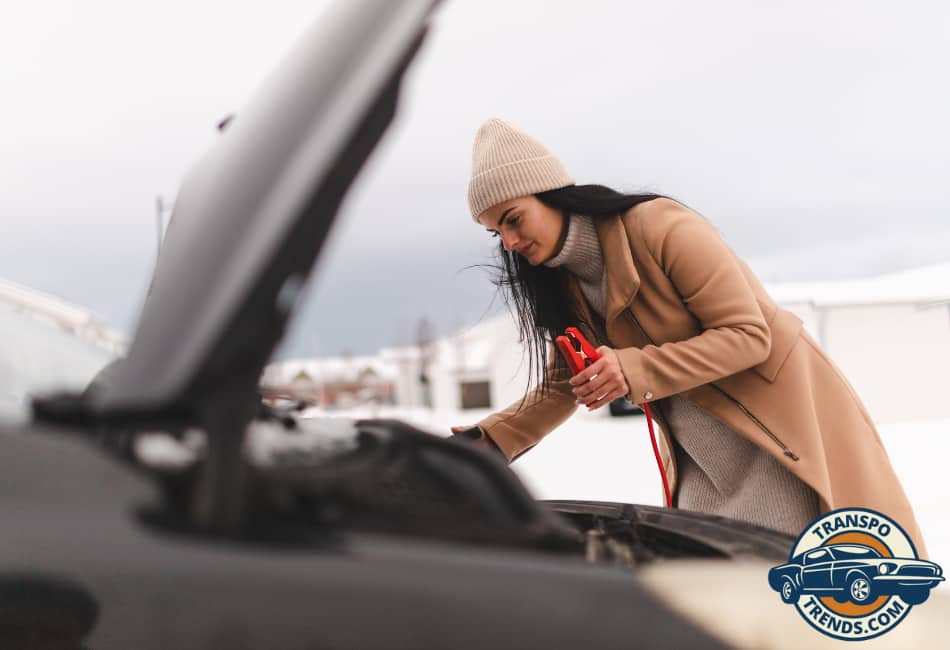Jump-starting a car is a crucial skill for drivers, especially for those owning automatic vehicles. Contrary to popular belief, automatic cars can indeed be jump-started just like any other car. However, it’s in your best interest to call for a rollback tow truck if your automatic car gets stuck.
This comprehensive guide will provide essential information on safely jump-starting an automatic car, debunking misconceptions, and exploring alternative options, ensuring you’re prepared for any roadside battery emergencies.
Can You Jump Start an Automatic Car?
The Common Misconception
Many people mistakenly believe that jump starting a car is only applicable to manual vehicles, leaving automatic car owners feeling uncertain about their options in case of a dead battery.
What they are often confused about is interchanging push start with jump start. You cannot push start an automatic car because the drivetrain does not allow for that.
This misconception likely stems also from the difference in driving mechanisms between manual and automatic transmissions.
However, it is essential to understand that both types of vehicles have batteries that can lose charge and require a jump start.
You can jump start an automatic car. Both automatic and manual vehicles have similar battery systems, which means the process of jump starting remains mostly the same.
The primary difference between the two transmissions lies in the gears and clutch operation, which do not affect the battery or jump starting procedure.
Just like their manual counterparts, automatic cars can experience a drained battery due to factors such as leaving the headlights on, extreme weather conditions, or an aging battery.
In these situations, jump starting your automatic car can be a practical and efficient solution to get back on the road quickly.
However, it is crucial to follow proper safety measures and guidelines to ensure a successful jump start without causing any damage to your vehicle or yourself.
Safety Considerations
Safety should always be your top priority when attempting to jump start an automatic car. The process involves working with electrical components and powerful batteries, which can pose potential hazards if not handled correctly.
By taking the necessary precautions and following the proper guidelines, you can minimize the risk of injury and prevent damage to your vehicle. Before you begin the jump starting process, keep the following safety precautions in mind:
Park in a Safe Location
Ensure that both vehicles are parked on level ground, away from traffic, and in a well-lit area. Engage the parking brake for both cars to prevent any movement during the jump start.
Turn off all Electrical Components
Switch off all electrical devices in both vehicles, including the headlights, air conditioning, radio, and any charging accessories. This step helps prevent power surges and reduces the load on the battery during the jump start.
Wear Protective Gear
Wearing gloves and safety glasses can protect your hands and eyes from potential harm caused by sparks, battery acid, or other debris.
Additionally, avoid wearing any loose clothing or jewelry that could get caught in the engine components.
Adhering to these safety precautions will increase the chances of a successful and safe jump start for your automatic car.
Procedure for Jump Starting an Automatic Car
Follow these step-by-step instructions for jump starting an automatic car safely and effectively:
1. Gather the Necessary Tools
Before starting, ensure you have a set of good-quality jumper cables and access to another vehicle with a functional, charged battery.
It is crucial to use jumper cables that are free from damage or corrosion and have sturdy clamps for a secure connection.
2. Position the Vehicles Properly
Park the assisting vehicle close to the one that needs a jump start, ensuring it is near enough for the jumper cables to reach both batteries but not touch each other. Turn off both engines and engage the parking brakes.
3. Connect the Jumper Cables Correctly
First, identify both car batteries’ positive (+) and negative (-) terminals. Then, follow these steps to connect the jumper cables:
- Attach one red clamp to the dead battery’s positive (+) terminal.
- Connect the other red clamp to the positive (+) terminal of the assisting vehicle’s battery.
- Attach one black clamp to the negative (-) terminal of the assisting vehicle’s battery.
- Finally, connect the other black clamp to an unpainted metal surface on the engine block or chassis of the car with the dead battery (this serves as a grounding point). Avoid connecting the black clamp directly to the dead battery’s negative (-) terminal, as it can cause sparks and increase the risk of explosion.
4. Start the Assisting Vehicle and Let it Run for a Few Minutes
Once the jumper cables are securely connected, start the assisting vehicle’s engine and let it idle for a few minutes.
This process allows the dead battery to receive some charge from the assisting vehicle’s battery before attempting to start the car.
5. Start the Automatic Car and Remove the Jumper Cables
After allowing the assisting vehicle to run for a few minutes, try starting the automatic car with the dead battery.
If it starts successfully, let it run for a while to help recharge the battery. Once the car is running, disconnect the jumper cables in the reverse order of how they were connected:
- Remove the black clamp from the grounding point on the previously dead car.
- Detach the black clamp from the negative (-) terminal of the assisting vehicle’s battery.
- Disconnect the red clamp from the positive (+) terminal of the assisting vehicle’s battery.
- Finally, remove the red clamp from the previously dead battery’s positive (+) terminal.
Keep the engine running on your automatic car for at least 20-30 minutes to ensure the battery gets adequately recharged.
If your car does not start after several attempts or continues to have issues, it may be time to seek professional assistance.
Potential Risks and Precautions
Jump starting an automatic car can come with potential risks. It’s crucial to be aware of these risks and take necessary precautions to ensure a safe and successful process.
Some potential risks associated with jump starting an automatic car include;
- Battery explosion: Batteries contain hydrogen gas, which can be highly flammable. If not handled carefully, sparks or improper connections could ignite the gas and cause the battery to explode.
- Electrical damage: Connecting jumper cables incorrectly or experiencing power surges during the jump start could lead to damage to your vehicle’s electrical system, including fuses, wiring, and sensitive electronic components.
- Physical injury: Mishandling jumper cables or not following proper safety measures could result in electric shocks, burns, or exposure to battery acid.
- Avoid revving the engine excessively: When jump starting an automatic car, refrain from revving the engine excessively. Doing so can cause strain on the transmission and may lead to long-term damage. Allow the car to idle and recharge the battery at a steady pace.
- Be cautious of electronic components: Automatic cars often have more electronic components than manual vehicles. Be mindful of these when connecting jumper cables and working around the engine bay to prevent any damage to sensitive components.
Alternative Options
If you’re unable to jump start your automatic car using another vehicle or prefer alternative methods, consider the following options:
Portable Jump Starters
Portable jump starters are compact, rechargeable devices designed to jump start a car without the need for another vehicle.
These devices typically come with built-in cables and clamps that connect directly to your car’s battery.
Many portable jump starters also include additional features such as USB ports for charging electronic devices, built-in flashlights, and air compressors for inflating tires.
To use a portable jump starter, follow the manufacturer’s instructions for connecting the device to your car’s battery.
Once connected, turn on the jump starter and attempt to start your car. After successfully starting your car, disconnect the jump starter and allow your car to run for a while to recharge the battery.
Call a Professional Roadside Assistance Service
In some cases, it may be more convenient or safer to call a professional roadside assistance service to help jump start your car.
Many insurance policies and auto clubs offer roadside assistance as part of their coverage, providing you with peace of mind in case of a dead battery or other roadside emergencies.
Roadside assistance professionals have the necessary tools and expertise to jump start your car safely and efficiently.
Additionally, they can help diagnose potential issues with your vehicle and recommend further action if needed, such as towing your car to a repair shop or replacing the battery.
By exploring these alternative options, you can choose the method that best suits your needs and ensures a safe and effective solution for jump starting your automatic car.
Battery Charger or Maintainer
A battery charger or maintainer can be a useful alternative if you have access to a power source and time to wait for the battery to recharge.
These devices connect to your car’s battery and an electrical outlet, slowly recharging the battery over several hours.
Battery chargers are available in various models, ranging from simple trickle chargers to advanced smart chargers with diagnostic capabilities.
A battery maintainer can also help prevent your battery from losing charge when the car is parked for extended periods.
Remember that using a battery charger or maintainer requires access to a power source and can take longer than other methods, but it can be a reliable and safe way to recharge your car’s battery without jump starting.
Conclusion
Jump starting an automatic car is a valuable skill that can help you get back on the road quickly in the event of a dead battery.
By following the proper procedure, understanding potential risks, and considering alternative options, you can safely and effectively jump start your automatic car.
Additionally, implementing good battery maintenance practices can help prevent future issues and extend the life of your car’s battery.
However, it’s essential to recognize when to call a professional, as they possess the expertise to diagnose and resolve more complex issues that may arise.
By being prepared and informed, you can confidently handle a dead battery situation and ensure the reliable performance of your automatic car for years to come.

